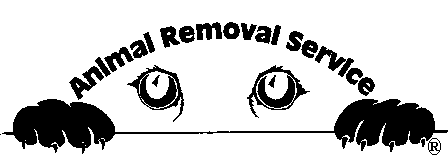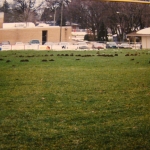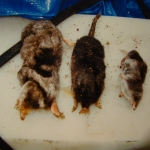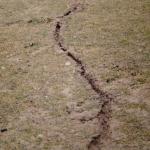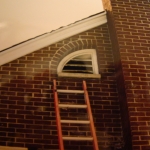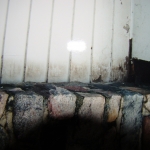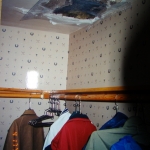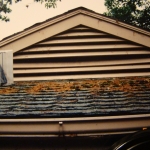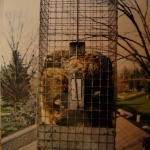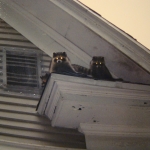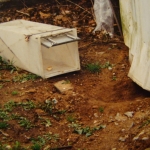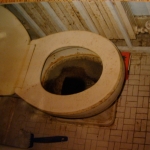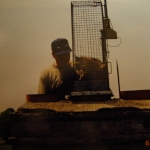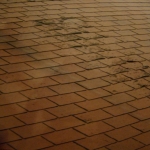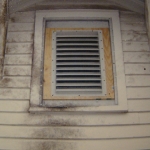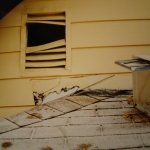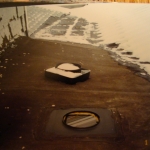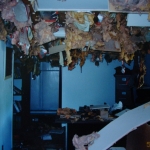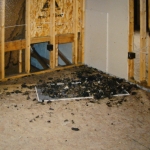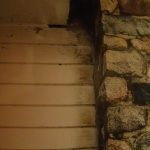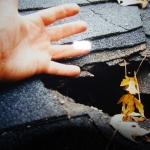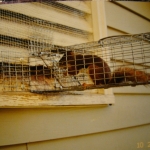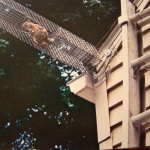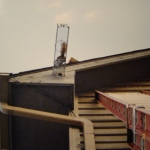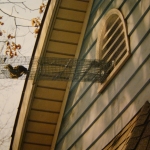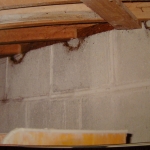Animal Identification and Behaviors
Animal Removal Services put our knowledge, experience, and resources to work to help you identify the animal that is invading your home or business and its behaviors. Learn more by clicking the animal name below or call us at (269) 327-9234 to get started.
- Lines of dead grass.
- Soft areas in lawn.
- Mounds of dirt.
Trapping is the most effective way to control moles. Damage range from shallow tunnels and raised trails in the lawn to mounds of dirt from deep tunnels. Moles are not a rodent and are related to shrews and bats. Nether the eyes or ears are visible and are concealed by fur. The front feet are very large, wider than they are long. The back feet are small and slender with sharp claws. Males are larger than females. Average total length (with tail) is 7 inches. Females average length is 6 5/8 inches. The experts say there are up to three to five moles per acre. I’ve personally removed 96 moles in one season from two acres. Nesting area is five to eight inches below the surface and about the size of a quart jar. Moles consume food equal to their body weight and more. They don’t hibernate and are active all year. They average 3 to 5 young born in March and early April. Trapping is the best method of control.
- Noise or scratching in fireplace or attic.
- Droppings on roof.
- Flea problem in house.
- Garbage cans raided.
- Cat/dog food missing.
- Sweet corn damage in garden.
A raccoon in the attic sounds like heavy walking, moving furniture or scratching,. They will also raid a bird feeder at night or a pet dish. A male raccoon home territory can range from 3 to 20 square miles. A female ranges from 1 to 6 square miles. A raccoon will access your roof or chimney from the trees close to the house, the downspouts or masonry on a chimney. Some people believe that by blocking them out of a structure they will leave. That is not necessary true, if they want in or out, they will dig through the shingles, plywood and rafters to get in or out. A raccoon will also dig in your yard looking for grubs, just like a skunk would. This digging appears to look like your yard being thatched or tilled. Raccoons will eat both meat and plants. Will mainly breed in February or March and babies will be born in born April or May. Raccoons only have one litter per year and average three to five young. Young are weaned at 2 to 4 months old. Raccoons will make their birthing home in attics, soffits, chimneys, under decks, in any type of out buildings or garages. Baby raccoons will make a chattering noise when calling for their mother.
- Odor
- Burrowing under buildings, deck or porch.
- Cone shape holes in yard.
- Sweet corn damage in garden.
- Flower bed or shrub damage from digging.
Skunks dig under porches, decks, sheds and near the foundation of a building. They will dig in your yard looking for grubs. Skunk damage appears to look like a thatching of the yard with holes about one inch in diameter and about half to one inch deep. Skunk is a member of the weasel family. They are mostly nocturnal and will eat meat and plants. Adult skunks breed in late February. Skunks can have anywhere from two to 16 young. A skunk lives anywhere from 3 to 10 years in the wild and have a range of half mile to two miles. Male skunks travel from four to five miles each night during mating season.
Opossums are a white or gray color and have a rat like tail. They average 4 pounds in weight (can be as much as 14 pounds). The can be found under decks, in window wells, sheds, garages or vacant woodchuck holes. Usually live alone and average a home range of 50 acres. They are mostly nocturnal. An opossum mates and the babies are born after 13 days and move into the pouch where they remain for 7 to 8 weeks. Opossum have an average of six to eight young but can have up to 16 young.
- Garden Damage
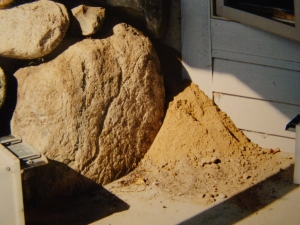
- Plants and Flowers Eaten
- 10-12″ holes in lawn, under deck, around buildings or under brush/debris piles
Woodchucks will dig a hole leaving a large dirt pile next to a building foundation, rock walls, out buildings, fence lines and open fields. These large holes and tunnels can undermine the foundation of a building or concrete slab. Woodchucks will eat all vegetation. Woodchucks start hibernating in late October to earlier November and stays there till late February or March. They breed in March/April and have litters of two to six.
- Noise in fireplace or attic
- Chewing around windows on inside of house or attic
A noise in the house may be a squirrel. The noise occurs often in early evening or early morning. You may hear a gnawing on the wood or nuts rolling. There are several different types of squirrels. A fox squirrel is brown, black or grey. They prefer oak, hickory and walnuts or osage orange fruits. They store their nuts for winter. In late winter and early spring they prefer to eat tree buds and may even eat animal matter. They often mark territory by chewing. Their scent glands are in their cheeks. They will breed at one year old in December/January and again in June. A young squirrel may breed only once in their first year. A squirrel will travel up to 50 miles in the fall to find better territory. They average 3 young.
A red squirrel is smaller than a fox squirrel and feed on the same kinds of nuts as a fox squirrel, however, they prefer pine nuts and buds. They are the most common squirrel found inside the home. A red squirrel will enter roof vents, ridge vents or chew through facia at the gutter and soffits and where two roof lines meet. Trapping is the best method of control.
Flying Squirrels are smaller than a red squirrel and are a grey or light brown color with webbing around the legs and a white belly. They are a nocturnal animal and you will hear them all night long. Flying squirrels will be out during the night raiding a bird feeder. They are more a colony type animal and can have a quite a few sharing the same space.
An eastern chipmunk is brown and has two tan and five blackish stripes on its back. They also have two tan and two brownish stripes on each side. A chipmunk is often confused with a thirteen strip ground squirrel or gopher. Typically inhabit mature woodlands and wood lots. Also like rock walls and landscape areas. Home range of chipmunk is a about a half acre and will protect their home entry within 50 feet. Most chipmunk tunnels are 20 to 30 feet long. Chipmunks do not enter a deep hibernation, they rely on their food storage to survive. They mate two times per year in spring and fall. They average 2 to 5 young and live up to 5 years. Trapping is the best method of control.
The house mouse is the most troublesome. Signs of mice will include noise in ceilings and walls at any time of day or night. They are a grayish brown color. They are mainly a nocturnal animal. If seen during the day could mean a high population. They average five to six young and five to ten litters per year and will breed in six to ten weeks. A white footed deer mouse has a brown body and white under belly. Baiting and trapping are the best method of control.
Gophers have thirteen stripes. They live in holes and are found in yards with little dirt at the hole. They will make trails in grass. Their diet consists of vegetation and animal matter. Rarely do they drink water getting moisture from their food source. They mate about 2 weeks after coming out of hibernation. They average 3 to 14 young.
A vole resembles a mouse but has a stocky body and is brown to grey in color. Voles are referred to as meadow mice. They are active in the day and night (no hibernation). They eat the best part of plants. Visible damage from voles are trails in the grass where they have eaten. After the snow leaves in spring you will see damage to your lawn, this damage is from voles and is often mistaken for mole damage. Trapping is the best method of control.
They are a single color of grey to black. There can be anywhere and to 2 to 70 shrews per acre. Their life span is one to two years. The main diet of a shrew is insects, small birds, mice and snakes. They consume three times their body weight every 24 hours. Baiting and trapping are the best method of control.
A rat is mostly nocturnal. Color of a rat can be about any color. You can find rats mostly around livestock pens where feed is present. They also can be found under buildings and decks and seldom travel more than 100 to 150 foot diameter. Trapping is most effective way to control rats. They average six to 12 young.
The most troublesome birds can be starlings. They nest in exhaust and dryer vents on houses resulting in plugged vents. Nesting material can plug a vent for 6 feet or more. After removing nesting material it is best to screen these vents from further birds nesting. The feces from birds perching can be annoying and hazardous to your health. Bird netting can be installed in troublesome areas to prevent birds from perching.
A muskrat is chocolate brown color with light grey under belly and have a scaled tail. They are threat to seawalls and lake edges. They also like to chew on boat wiring. They may spend winter months in shrubbery and around buildings.
A mink is a dark to chocolate brown and have a furry tail (as opposed to a muskrat that has a scaled tail). They are a threat to poultry and fish ponds. Trapping is the best method of control.
A beaver is black or chocolate brown in color and has a hairless large flat tail. They can be found anywhere there is water. They will build dams to modify their environment. Beavers prefer to chew the bark off trees. Beaver are usually active at night for about 12 hours. Beaver is the largest north American rodent. Most adults range from 35 to 50 pounds. Occasionally reaching from 75 to 80. It is an aquatic animal and lives normally in rivers and streams creating their own ponds. They will give birth to 3 to 4 kittens between March and June. They can live up to 21 years but most live about 10 years. Beavers are territorial. A colony usually consist of 4 to 8 related beavers. Trapping is the best method for control.
There are red and grey fox. Red fox can be found in residential areas. A grey fox is usually found in woodlots and swamps. A red fox will den under decks and outbuildings. Neither pose a threat to humans in my opinion. They do control the population of rodents, rabbits and woodchucks. Trapping is the best method of control.
Looks like a small German Shepard. Preys on livestock and pets. Will jump a five foot fence to get at their prey. Trapping is the best method of control.
We can pick up dead deer and dispose of them.
Snakes can be found in a house, out building, wood lots or just about anywhere. Most snakes are complete harmless with the exception of rattle snakes. Trapping is the best method of control.
Live only 12 to 15 months. Have as many as six litters a year. They usually breed again in as little as two hours after birth. The young leave the nest at two to three weeks. Best control method is fencing around plants. A special permit from the Department of Natural Resources may be required to trap them.
Chemical application to the perimeter of a building is the best control of bugs, ants, etc. A minimum of two chemical applications (Spring and Fall) is recommend.
Bees are best controlled by chemical application to the nest. Except for honey bees. A beekeeper can be hired to remove honey bees.
